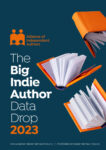Last week the ALLi blog explored slow-releasing as a self-publishing model; the practise of publishing books over a longer time period. On the opposite end of the spectrum, a strategy that has gained significant traction amongst self-published authors in recent years is rapid releasing. Loved by some, and feared by others, this fast-moving publishing model has pros and cons that may impact your decision to give it a go.
In today’s post, we'll explore why rapid releasing can be a powerful tool for independent authors, alongside the challenges you may face, and share some inspiring examples of authors who have mastered the model.

Photo by Guillaume Jaillet on Unsplash
What is rapid releasing?
Rapid release, in the context of self-publishing, refers to the practice of consistently publishing multiple books within a relatively short time period, and with minimal gaps between releases. Some authors using this model will launch a series of books with each going live just weeks apart.
Authors taking this approach either write consistently and quickly between releases, or write for an intense period upfront and, only once several books or even a complete series is finished, release each one across a carefully managed rapid-release schedule.
By maintaining this consistent and speedy release of each book, authors aim to capitalize on reader interest from one book to the next and ultimately build a dedicated fan base who return to their work consistently.
Who is rapid release suitable for?
Rapid release isn’t right for everyone. Firstly, it is of course most suited to those authors who are prolific writers, producing regularly and consistently. If you prefer a slower-pace of writing, with your goals looking ahead by months or years for each book, this is not for you.
Many feel the model is best suited to those who write in genres that are known for long series’ and avid (or sometimes called ‘binge’) readers. For this reason, crime, romance, fantasy and other popular fiction genres tend to be represented most often amongst those authors successfully using the rapid-release model.
Finally, and this isn’t a hard and fast rule, but many believe rapid release is most suited to those who already have an established audience and related channels to reach them. Why is this? Well, as you’ll see later in this post, rapid release can be a risky approach if you aren’t sure you have the audience to support the time, energy and financial investment needed to produce many books in quick succession or up front.
Why rapid release your books?
If you are considering this approach, you will be committing to an intense release plan, so understanding the potential benefits is key. And number one amongst these must be the opportunity to build up a large collections of books to your name quickly, released consistently.
 Data collected for the ALLi Big Data Drop this year included insight from the 2019 Written Word Media survey, that one of the key success criteria for indie authors was “writing more books”. In fact, those earning over $60k had released over 20 books on average, with those over $100k having released over 25. There is nothing like a rapid-release schedule to motivate an author to build their collection.
Data collected for the ALLi Big Data Drop this year included insight from the 2019 Written Word Media survey, that one of the key success criteria for indie authors was “writing more books”. In fact, those earning over $60k had released over 20 books on average, with those over $100k having released over 25. There is nothing like a rapid-release schedule to motivate an author to build their collection.
It's understood that platforms like Amazon also reward high-numbers of consistent releases with better visibility and promotional opportunities, potentially boosting your chances of getting featured in “also-bought” and “recommended for you” sections.
For any data-heads, you can read more about the findings from across a range of indie-author research in ALLi's Big Indie Author Data Drop 2023 Report.
But that's not all…
There's more than just quantity to recommend the rapid-release strategy. A few more benefits include:
- Increasing Visibility and Engagement: Releasing multiple books in quick succession keeps readers engaged and invested in your work. As they finish one book, they can immediately move on to the next, increasing the chances of retaining their interest. Readers who enjoyed one book are more likely to purchase the next one in the series.
- Building Your Author Brand: Consistent rapid releases help establish your brand as a prolific author. This can be an attractive factor for readers, agents, and the wider industry looking for new talent to share and champion. Many avid readers love discovering new series they can immerse themselves in over a long period of time. Rapid releasing satisfies this craving and can turn onetime readers into loyal fans.
- Dividing a Large Novel: Sometimes your story can get out of hand… and if what was planned to be one novel turns into a 300k or 500k epic, rapid release can be a great way to break up the story, but still maintain fast movement through the action. A secondary bonus of breaking up a long novel is that readers will be happy to pay for each instalment separately, and you reduce the print cost, which can expand dramatically over a certain amount of pages.

Photo by micheile henderson on Unsplash
Challenges you may face with rapid release
While rapid releasing offers numerous advantages, it's not without its challenges, not least of which is the financial risk an author has to take.
As implied in the introduction to this post, it’s not unheard of for an author to spend several years writing a series planned for quick release, only to discover just one or two books into the release schedule that it hasn’t achieved the following they’d hoped. This can mean many months or years of story development have been wasted. Bear in mind that much of the costs (such as editing, formatting, cover design) will have been paid up front too.
A few more challenges to consider include:
- Quality Control: The pressure to release books quickly can lead to quality issues if you rush the writing, editing, or proofreading process. Maintaining high standards is crucial to maintain reader trust.
- Burnout: Writing, editing, and publishing at a breakneck pace can lead to burnout. Authors must find a sustainable rhythm that works for them. Some authors will rapid release a series and then require many months or even years break before their creative juices are flowing again. And readers accustomed to rapid releases from an author may become impatient if there are gaps between your books.
- Marketing Overload: Related to the point above, effectively promoting multiple books simultaneously and in quick succession can be overwhelming. Indie authors may need to allocate more time and resources to marketing efforts, such as managing reviews for each launch, coordinating with book bloggers and influencers, posting across their own channels and producing marketing assets and newsletters. As you release each book, your marketing activity will overlap and can become overwhelming if not planned and managed carefully.

Author insights: planning a successful rapid-release plan
We've covered the pros and the cons of rapid release, the next step is to consider what practical steps you can take to plan for and manage the process successfully. Two ALLi members share their experiences, from how to set the right rapid-release mindset, to how many manuscripts to have prepared before you kick off your release schedule.
The prolific author mindset: insight from author Carissa Andrews
As well as founding Author Revolution, Carissa Andrews is also an indie author with over 17 books to her name; the majority were published across just four years. Clarissa shared three key behaviours she sees in successful prolific authors in a podcast with ALLi in April last year. Three top takeaways are edited and included below.
Avoiding perfectionism and knowing when to let go:
You need to be able to persevere no matter what, because prolific authors, they don't get distracted by perfectionism. Oh, did I just hear a pin drop? Perfectionism is keeping you stuck (…) You need to be able to look at your job, your creation, your product, and know when to cut it loose, know when to let it go. You don't get stuck with perfectionism.
Planning ahead and communicating well:
That means knowing in advance how many books you're going to write, how many books you want to publish each and every year? Can you put your pre-orders up there so that your readers are aware that your books are coming? Prolific authors need to have that structure in place so that it keeps them accountable, and it keeps the readers in-the-know. It gives them that clear guideline on what's happening and how it's going to go down.
Setting goals and sticking to them:
Prolific authors set goals, the big goals, the small goals, the monetary goals, the word count goals, the daily goals. They have goals and they stick to them, and you don't have to have a bazillion different things going on in your head. It doesn't have to be 900 different goals. Your main goal could just be, I'm going to publish four books a year. Boom, that's your goal. Then you just work back and try to make it into those manageable bite-sized chunks.
Listen to the full interview, or read the transcript, including Carissa’s four phases for self-publishing books in the ALLi Podcast: Writing for Rapid Release.

Michael La Ronn
Member rapid-release tips: Michael La Ronn
Michael La Ronn is both an author and ALLi team member. He has used a rapid release strategy for several series. Here, he shares his key lessons and watch-outs from the experience:
Why rapid release?
- I’ve found some readers flat out won't buy a series until it is complete, so if you release a series slowly, you've got that working against you – more books always look more appealing when readers encounter a series for the first time.
- Rapid release allows you as the writer to move swiftly through a series, which suits my writing pace.
My key lessons from rapid-releasing books:
- The sooner you release titles after one another, the better.
- Having at least two books ready at launch helps.
- If releasing a series, you want to aim for a critical mass of at a minimum of three books, so the series “feels” complete.
My main watch-outs from rapid releasing books:
- Rapid-releasing is an expensive path. You'll have to have all your covers designed and manuscripts edited upfront or very close together. You'll also have to coordinate your freelancers' schedules, which can be challenging. Planning is important.
- If you're unknown, there's no guarantee that rapid releasing will work. It tends to work better once you've developed a minimal readership.
- Be careful about your story. As soon as you publish a title, you're committing it to the series canon. While this is always an issue for a series, it's especially an issue if you rapid release. This is why ensuring you have high-quality editing is so important.

Photo by Susan Q Yin on Unsplash
Research rapid-releasers from your niche
If you are starting to think this model may be for you, consider researching more examples of authors in your genre or niche taking this approach to see how they have made it work. Exploring others who have successfully taken this route can be an inspiring and practical place to start for your own plan.
The following indie authors have demonstrated that rapid releasing can be a successful approach for self-publishing across various genres. Pick one related to your niche, and take a look at how they position their work, and get an idea of the time they leave between each book by looking at their release dates on Amazon or another platform. You could even follow their marketing activity in the run up to a launch. This can give you a good sense of what might work for you.
Fantasy and Science Fiction: Author Inspiration
- Michael Anderle: Anderle is the author behind the popular “Kurtherian Gambit” urban fantasy series. With over 200 books released in less than five years, the rapid-release strategy he and his wife Judith developed has generated a massive fan base and substantial income. He is also a founder of the 20booksto50k concept and community based on the simple idea that if you write 20 books, you are more likely to make around $50k a year. His publishing company now releases up to 12 books a month working with other indie authors.
- Lindsay Buroker: Lindsay Buroker is an accomplished fantasy and science fiction author who has been indie publishing since ebooks really took off around 2010. She is known for her “Emperor's Edge” and “Dragon Blood” series among others and has embraced rapid releasing and series production from early on.
- Sean Platt and Johnny B. Truant: Platt and Truant, are co-authors and founders of the Sterling & Stone publishing company. They have employed rapid releasing for various fantasy and science fiction series, including “The Beam” and “The Invasion”. The duo are considered by many to be pioneers in the field, demonstrating how consistently publishing high-quality books can lead to substantial success.
- Glynn Stewart: Stewart is known for his space opera and science fiction series, such as “The Duchy of Terra” and “Starship's Mage.” He has adopted rapid releasing to maintain reader engagement and has attracted a loyal following, now publishing through his own imprint dedicated to his work.
Romance: Author Inspiration
- Bella Forrest: Forrest is perhaps best known for her first series, “A Shade of Vampire”, which has over 100 books and counting! She mastered the art of rapid releasing in the paranormal romance genre, capturing a dedicated fan base that eagerly awaits each new instalment in both this series and several others.
- Meghan March: since leaving her corporate role in mergers and acquisitions, Meghan March has successfully employed rapid releasing in the romance genre, particularly with her “Beneath” and “Dirty Billionaire” series. Her quick publication schedule has helped build anticipation among readers, resulting in impressive sales.
- Amanda Hocking: Known for her paranormal romance series, Amanda Hocking's rapid-releasing strategy catapulted her to fame. She published numerous titles within a short span and sold millions of copies, eventually signing a traditional publishing deal.
- J.A. Huss: J.A. Huss is renowned for her prolific output, particularly in the romance and suspense genres. She designs all her own covers, websites, promotional graphics, and book trailer videos, and is still committed to consistent rapid release schedules.
Crime, Thriller and Mystery: Author Inspiration
- Mark Dawson: Dawson is perhaps best known in indie circles as the brains behind the Self-Publishing Formula. Although he may not be considered a pure rapid-releaser, his fast schedule and consistent delivery could put him in this category, and for writers of thriller and crime there is a lot to learn from his approach.
- Russel Blake: with over 60 novels published, Blake has spoken about writing upwards of 10,000 words a day. He is best known for his thriller series' but also writes non-fiction, YA and romance under a pen name, and co-writes with other authors.
- Kate P. Adams: starting off in non-fiction, Kate P. Adams began rapid releasing cozy mystery novels in 2022 with the Charleton House Mysteries. She brought her knowledge of English Stately homes from her previous career in England to the collection, which already has over ten books in the series.
- Ellery Adams: Adams has released a range of series' often set around cafes, bookshops and pie shops. She has also produced her own cookbooks to expand her reader offer.
So… is rapid-release for you?
Rapid releasing is a powerful strategy that can propel independent authors to success in the ever-competitive world of self-publishing.
By releasing books in quick succession, authors can increase visibility, engage readers, and boost their income. This is particularly true in some genres, where enduring series' are popular amongst avid readers.
However, it can be a risky strategy without a known fan-base, as upfront time and financial commitments are needed. It is also essential to balance speed with quality, and ensure this intense approach does not lead to burnout.
Multiple best-selling indie authors, however, have shown time and time again that with the right content and a dedicated approach there are positives to be gained from rapid release, not least a dedicated following and increased sales.
Find out more about a slower pace of publishing: slow-release strategies
Have you read this post and think the requirements of rapid release may not be for you? If so, you can find out about a model more suited to those working at a slower pace, with our post exploring slow-releasing strategies for indie authors.






Would you agree RAPID RELEASE is also a way to attract an EDITOR when you are too Old to ensure them a profitable writer’s career ?
I am 80 and I plan to propose a three books set whose first is already written, second has a detailed plan and third is at the idea stage.
The three being coherent stories.
My B plan is self editing.
Thank you for your attention.
Didier LOMBARD